Smoking as a Health Issue: Factors, Strategies, and Nurse Role
VerifiedAdded on 2022/10/08
|14
|3343
|14
Report
AI Summary
This report delves into smoking as a significant global health issue, analyzing its various facets and implications. It begins by identifying smoking as a preventable cause of death, highlighting the substantial number of smokers in England and the associated mortality rates. The report explores the multifaceted factors influencing smoking habits, including cultural and socioeconomic influences. It examines the evolution of societal acceptance of smoking, the role of advertising, and the impact of socioeconomic status on smoking prevalence. Furthermore, the report investigates health promotion strategies, such as taxation on tobacco products and anti-smoking legislation, evaluating their effectiveness in reducing tobacco consumption. The report also emphasizes the critical role of nurses in treating patients with smoking addictions, detailing their responsibilities in adult, learning disability, and child care. The report references the importance of understanding the impact of smoking, the strategies for health promotion, and the role of nurses in patient care.
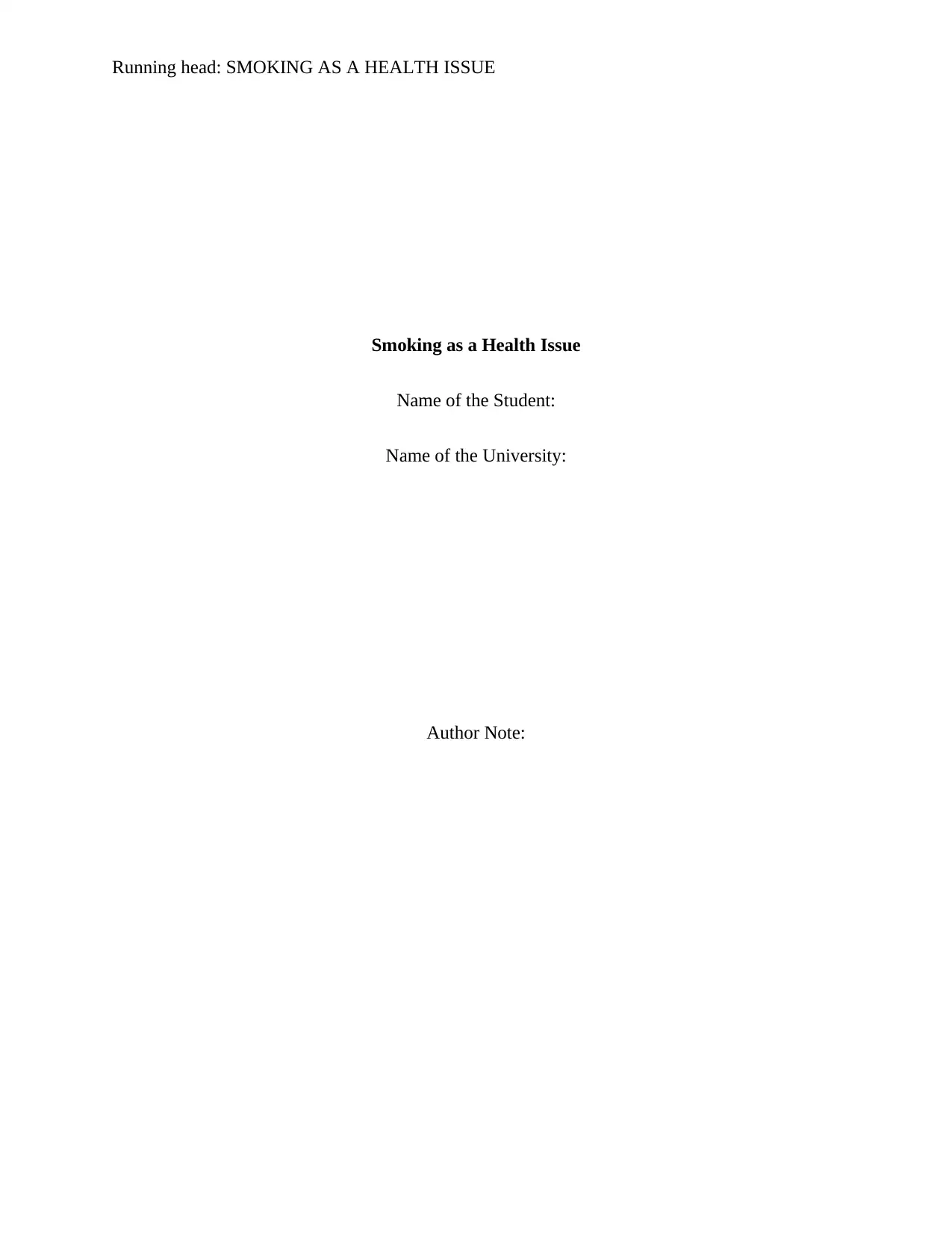
Running head: SMOKING AS A HEALTH ISSUE
Smoking as a Health Issue
Name of the Student:
Name of the University:
Author Note:
Smoking as a Health Issue
Name of the Student:
Name of the University:
Author Note:
Paraphrase This Document
Need a fresh take? Get an instant paraphrase of this document with our AI Paraphraser
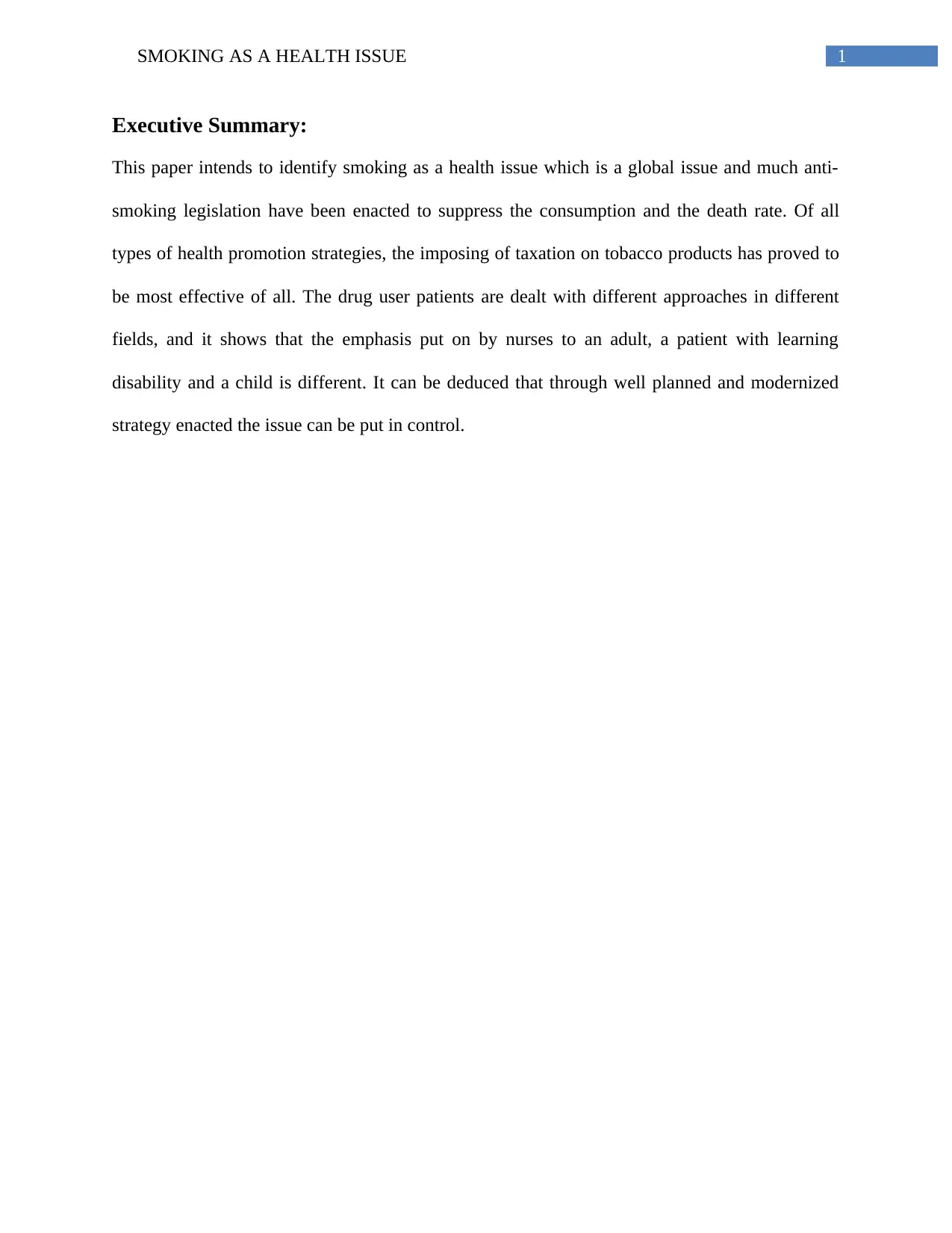
1SMOKING AS A HEALTH ISSUE
Executive Summary:
This paper intends to identify smoking as a health issue which is a global issue and much anti-
smoking legislation have been enacted to suppress the consumption and the death rate. Of all
types of health promotion strategies, the imposing of taxation on tobacco products has proved to
be most effective of all. The drug user patients are dealt with different approaches in different
fields, and it shows that the emphasis put on by nurses to an adult, a patient with learning
disability and a child is different. It can be deduced that through well planned and modernized
strategy enacted the issue can be put in control.
Executive Summary:
This paper intends to identify smoking as a health issue which is a global issue and much anti-
smoking legislation have been enacted to suppress the consumption and the death rate. Of all
types of health promotion strategies, the imposing of taxation on tobacco products has proved to
be most effective of all. The drug user patients are dealt with different approaches in different
fields, and it shows that the emphasis put on by nurses to an adult, a patient with learning
disability and a child is different. It can be deduced that through well planned and modernized
strategy enacted the issue can be put in control.
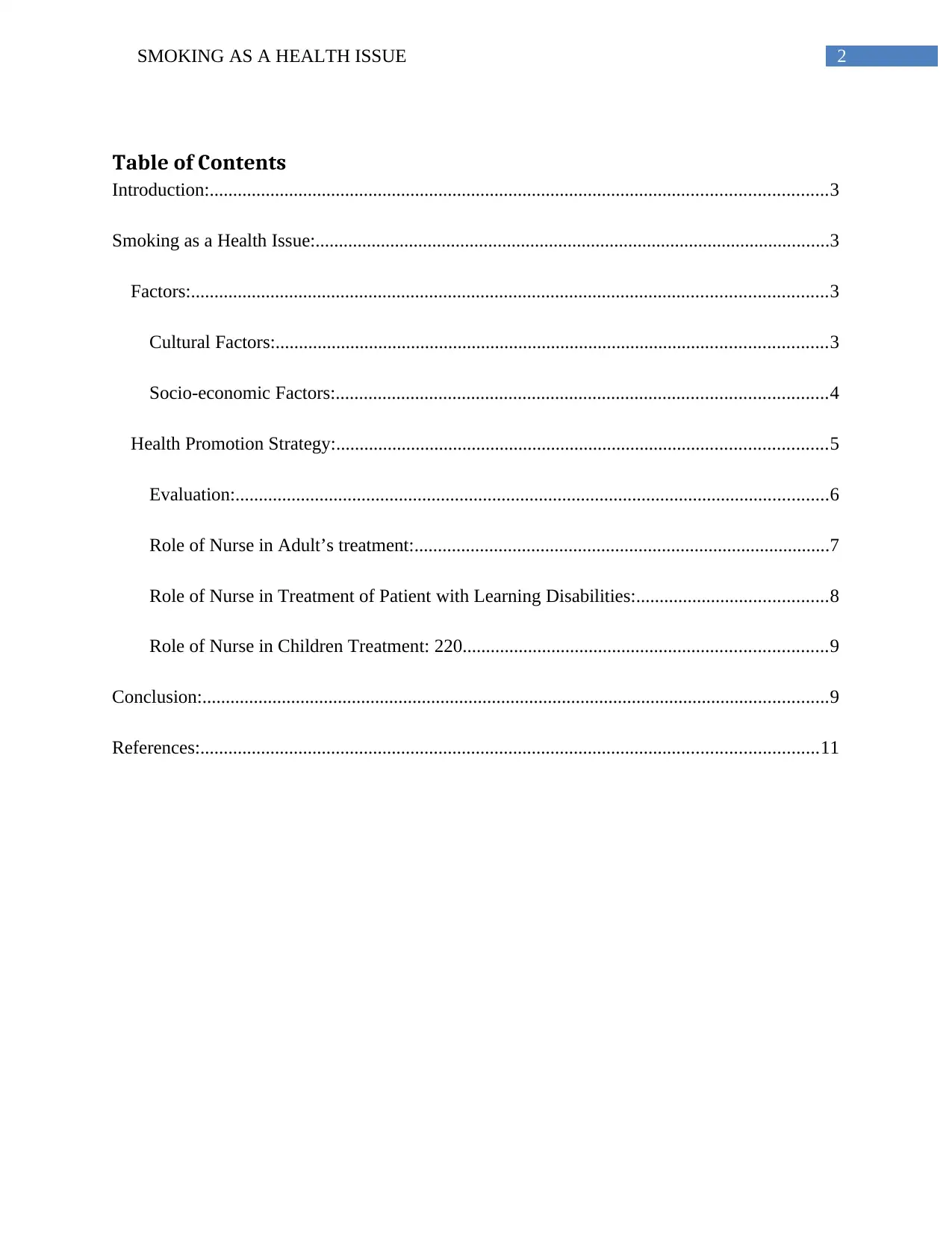
2SMOKING AS A HEALTH ISSUE
Table of Contents
Introduction:....................................................................................................................................3
Smoking as a Health Issue:..............................................................................................................3
Factors:........................................................................................................................................3
Cultural Factors:......................................................................................................................3
Socio-economic Factors:.........................................................................................................4
Health Promotion Strategy:.........................................................................................................5
Evaluation:...............................................................................................................................6
Role of Nurse in Adult’s treatment:.........................................................................................7
Role of Nurse in Treatment of Patient with Learning Disabilities:.........................................8
Role of Nurse in Children Treatment: 220..............................................................................9
Conclusion:......................................................................................................................................9
References:....................................................................................................................................11
Table of Contents
Introduction:....................................................................................................................................3
Smoking as a Health Issue:..............................................................................................................3
Factors:........................................................................................................................................3
Cultural Factors:......................................................................................................................3
Socio-economic Factors:.........................................................................................................4
Health Promotion Strategy:.........................................................................................................5
Evaluation:...............................................................................................................................6
Role of Nurse in Adult’s treatment:.........................................................................................7
Role of Nurse in Treatment of Patient with Learning Disabilities:.........................................8
Role of Nurse in Children Treatment: 220..............................................................................9
Conclusion:......................................................................................................................................9
References:....................................................................................................................................11
⊘ This is a preview!⊘
Do you want full access?
Subscribe today to unlock all pages.

Trusted by 1+ million students worldwide
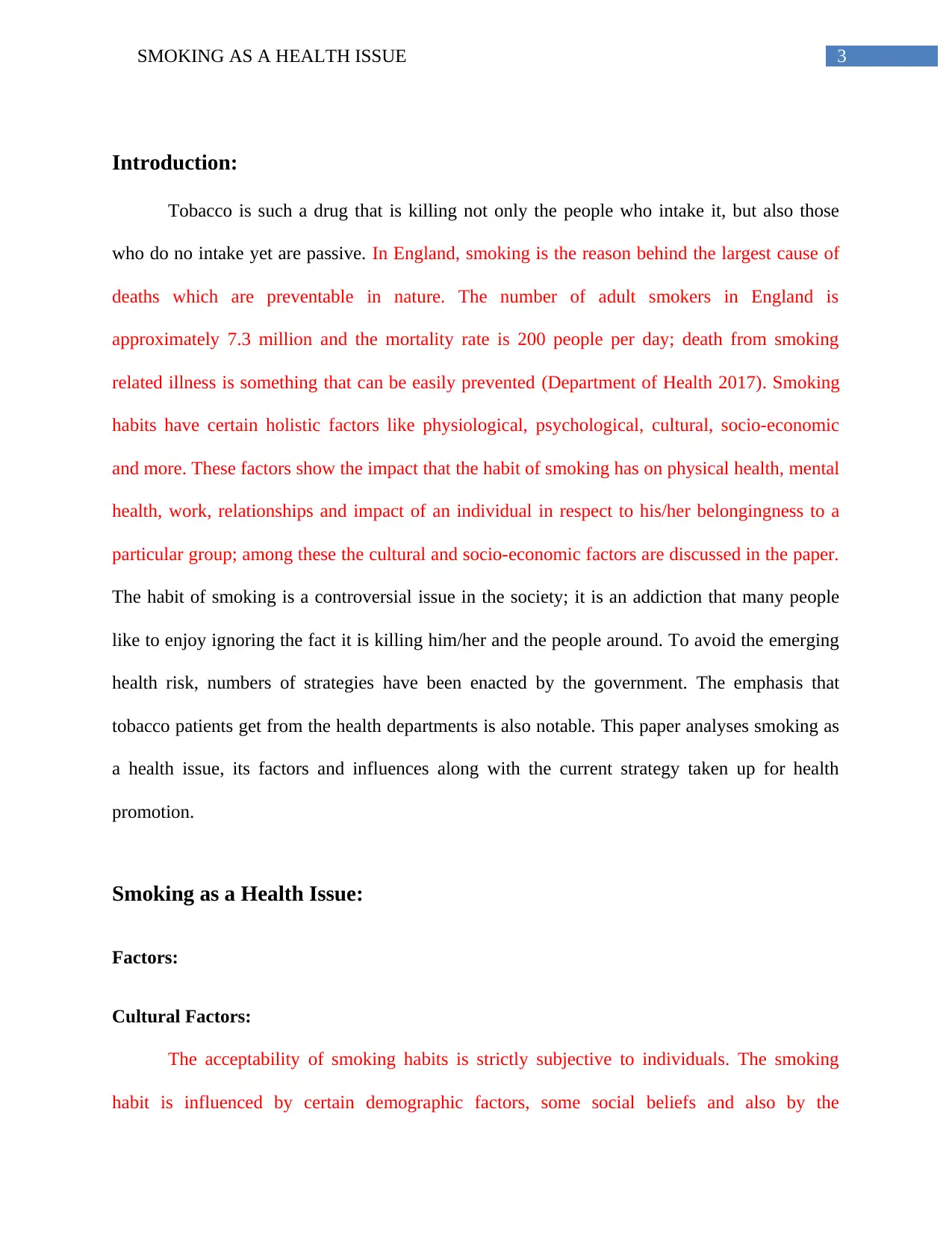
3SMOKING AS A HEALTH ISSUE
Introduction:
Tobacco is such a drug that is killing not only the people who intake it, but also those
who do no intake yet are passive. In England, smoking is the reason behind the largest cause of
deaths which are preventable in nature. The number of adult smokers in England is
approximately 7.3 million and the mortality rate is 200 people per day; death from smoking
related illness is something that can be easily prevented (Department of Health 2017). Smoking
habits have certain holistic factors like physiological, psychological, cultural, socio-economic
and more. These factors show the impact that the habit of smoking has on physical health, mental
health, work, relationships and impact of an individual in respect to his/her belongingness to a
particular group; among these the cultural and socio-economic factors are discussed in the paper.
The habit of smoking is a controversial issue in the society; it is an addiction that many people
like to enjoy ignoring the fact it is killing him/her and the people around. To avoid the emerging
health risk, numbers of strategies have been enacted by the government. The emphasis that
tobacco patients get from the health departments is also notable. This paper analyses smoking as
a health issue, its factors and influences along with the current strategy taken up for health
promotion.
Smoking as a Health Issue:
Factors:
Cultural Factors:
The acceptability of smoking habits is strictly subjective to individuals. The smoking
habit is influenced by certain demographic factors, some social beliefs and also by the
Introduction:
Tobacco is such a drug that is killing not only the people who intake it, but also those
who do no intake yet are passive. In England, smoking is the reason behind the largest cause of
deaths which are preventable in nature. The number of adult smokers in England is
approximately 7.3 million and the mortality rate is 200 people per day; death from smoking
related illness is something that can be easily prevented (Department of Health 2017). Smoking
habits have certain holistic factors like physiological, psychological, cultural, socio-economic
and more. These factors show the impact that the habit of smoking has on physical health, mental
health, work, relationships and impact of an individual in respect to his/her belongingness to a
particular group; among these the cultural and socio-economic factors are discussed in the paper.
The habit of smoking is a controversial issue in the society; it is an addiction that many people
like to enjoy ignoring the fact it is killing him/her and the people around. To avoid the emerging
health risk, numbers of strategies have been enacted by the government. The emphasis that
tobacco patients get from the health departments is also notable. This paper analyses smoking as
a health issue, its factors and influences along with the current strategy taken up for health
promotion.
Smoking as a Health Issue:
Factors:
Cultural Factors:
The acceptability of smoking habits is strictly subjective to individuals. The smoking
habit is influenced by certain demographic factors, some social beliefs and also by the
Paraphrase This Document
Need a fresh take? Get an instant paraphrase of this document with our AI Paraphraser
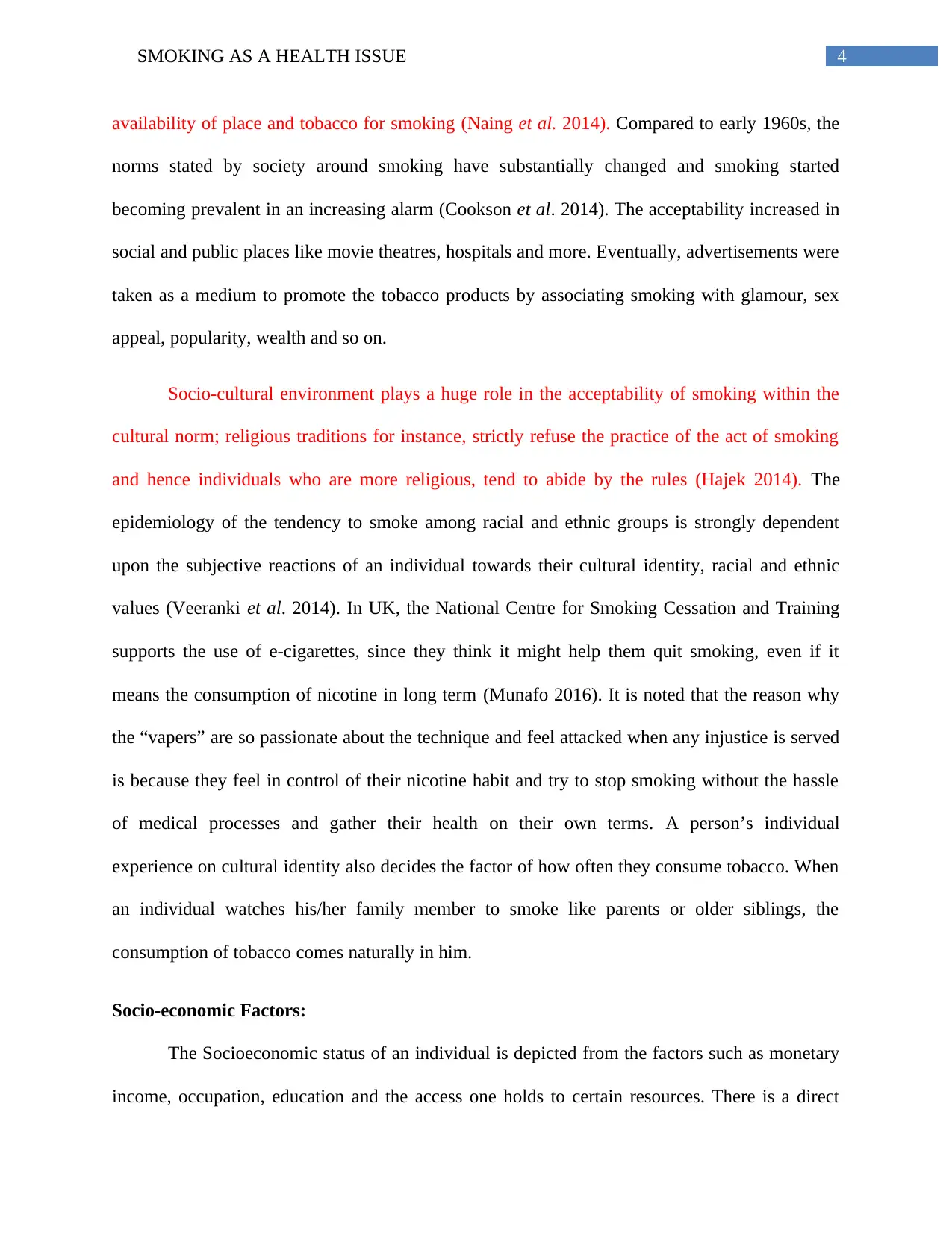
4SMOKING AS A HEALTH ISSUE
availability of place and tobacco for smoking (Naing et al. 2014). Compared to early 1960s, the
norms stated by society around smoking have substantially changed and smoking started
becoming prevalent in an increasing alarm (Cookson et al. 2014). The acceptability increased in
social and public places like movie theatres, hospitals and more. Eventually, advertisements were
taken as a medium to promote the tobacco products by associating smoking with glamour, sex
appeal, popularity, wealth and so on.
Socio-cultural environment plays a huge role in the acceptability of smoking within the
cultural norm; religious traditions for instance, strictly refuse the practice of the act of smoking
and hence individuals who are more religious, tend to abide by the rules (Hajek 2014). The
epidemiology of the tendency to smoke among racial and ethnic groups is strongly dependent
upon the subjective reactions of an individual towards their cultural identity, racial and ethnic
values (Veeranki et al. 2014). In UK, the National Centre for Smoking Cessation and Training
supports the use of e-cigarettes, since they think it might help them quit smoking, even if it
means the consumption of nicotine in long term (Munafo 2016). It is noted that the reason why
the “vapers” are so passionate about the technique and feel attacked when any injustice is served
is because they feel in control of their nicotine habit and try to stop smoking without the hassle
of medical processes and gather their health on their own terms. A person’s individual
experience on cultural identity also decides the factor of how often they consume tobacco. When
an individual watches his/her family member to smoke like parents or older siblings, the
consumption of tobacco comes naturally in him.
Socio-economic Factors:
The Socioeconomic status of an individual is depicted from the factors such as monetary
income, occupation, education and the access one holds to certain resources. There is a direct
availability of place and tobacco for smoking (Naing et al. 2014). Compared to early 1960s, the
norms stated by society around smoking have substantially changed and smoking started
becoming prevalent in an increasing alarm (Cookson et al. 2014). The acceptability increased in
social and public places like movie theatres, hospitals and more. Eventually, advertisements were
taken as a medium to promote the tobacco products by associating smoking with glamour, sex
appeal, popularity, wealth and so on.
Socio-cultural environment plays a huge role in the acceptability of smoking within the
cultural norm; religious traditions for instance, strictly refuse the practice of the act of smoking
and hence individuals who are more religious, tend to abide by the rules (Hajek 2014). The
epidemiology of the tendency to smoke among racial and ethnic groups is strongly dependent
upon the subjective reactions of an individual towards their cultural identity, racial and ethnic
values (Veeranki et al. 2014). In UK, the National Centre for Smoking Cessation and Training
supports the use of e-cigarettes, since they think it might help them quit smoking, even if it
means the consumption of nicotine in long term (Munafo 2016). It is noted that the reason why
the “vapers” are so passionate about the technique and feel attacked when any injustice is served
is because they feel in control of their nicotine habit and try to stop smoking without the hassle
of medical processes and gather their health on their own terms. A person’s individual
experience on cultural identity also decides the factor of how often they consume tobacco. When
an individual watches his/her family member to smoke like parents or older siblings, the
consumption of tobacco comes naturally in him.
Socio-economic Factors:
The Socioeconomic status of an individual is depicted from the factors such as monetary
income, occupation, education and the access one holds to certain resources. There is a direct
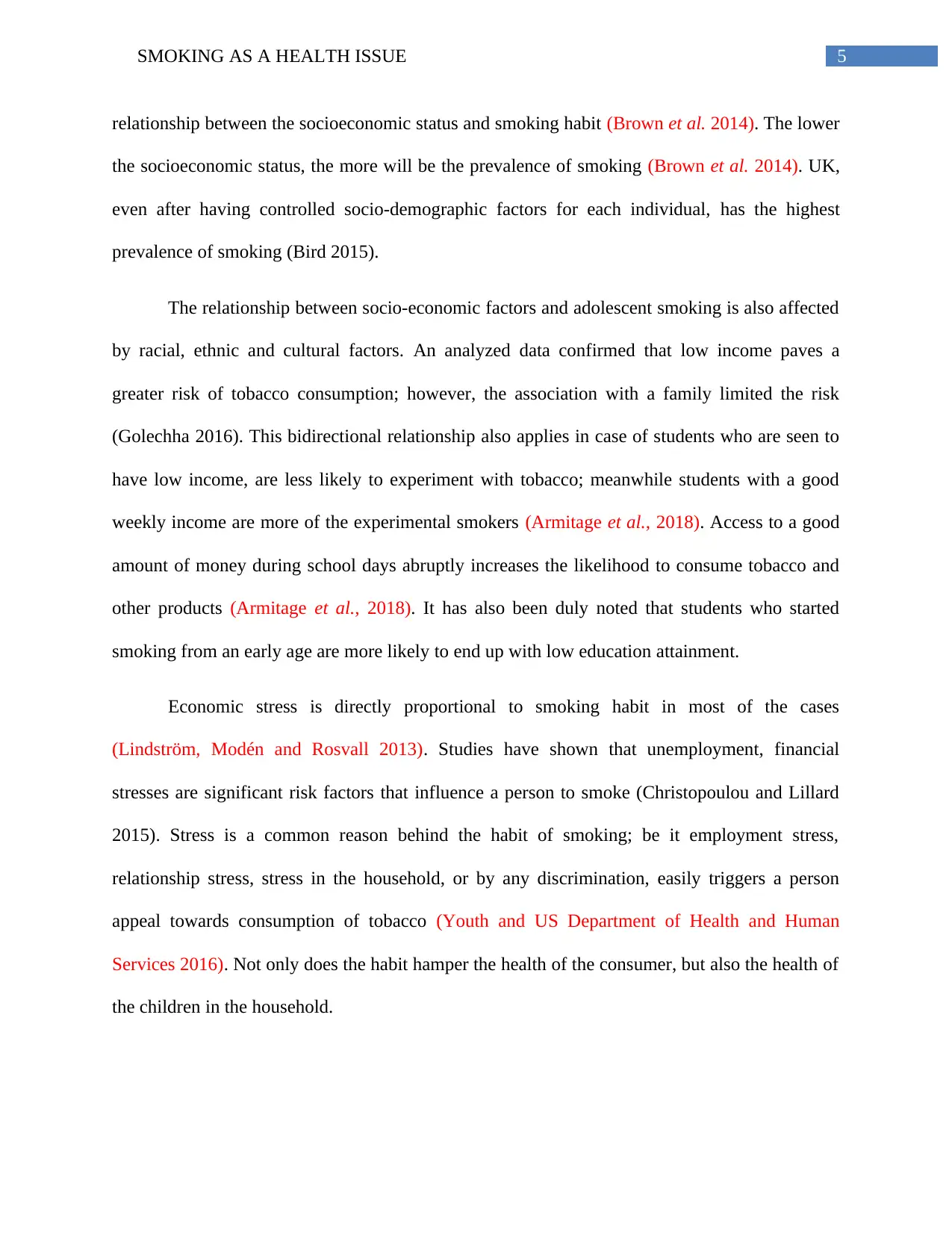
5SMOKING AS A HEALTH ISSUE
relationship between the socioeconomic status and smoking habit (Brown et al. 2014). The lower
the socioeconomic status, the more will be the prevalence of smoking (Brown et al. 2014). UK,
even after having controlled socio-demographic factors for each individual, has the highest
prevalence of smoking (Bird 2015).
The relationship between socio-economic factors and adolescent smoking is also affected
by racial, ethnic and cultural factors. An analyzed data confirmed that low income paves a
greater risk of tobacco consumption; however, the association with a family limited the risk
(Golechha 2016). This bidirectional relationship also applies in case of students who are seen to
have low income, are less likely to experiment with tobacco; meanwhile students with a good
weekly income are more of the experimental smokers (Armitage et al., 2018). Access to a good
amount of money during school days abruptly increases the likelihood to consume tobacco and
other products (Armitage et al., 2018). It has also been duly noted that students who started
smoking from an early age are more likely to end up with low education attainment.
Economic stress is directly proportional to smoking habit in most of the cases
(Lindström, Modén and Rosvall 2013). Studies have shown that unemployment, financial
stresses are significant risk factors that influence a person to smoke (Christopoulou and Lillard
2015). Stress is a common reason behind the habit of smoking; be it employment stress,
relationship stress, stress in the household, or by any discrimination, easily triggers a person
appeal towards consumption of tobacco (Youth and US Department of Health and Human
Services 2016). Not only does the habit hamper the health of the consumer, but also the health of
the children in the household.
relationship between the socioeconomic status and smoking habit (Brown et al. 2014). The lower
the socioeconomic status, the more will be the prevalence of smoking (Brown et al. 2014). UK,
even after having controlled socio-demographic factors for each individual, has the highest
prevalence of smoking (Bird 2015).
The relationship between socio-economic factors and adolescent smoking is also affected
by racial, ethnic and cultural factors. An analyzed data confirmed that low income paves a
greater risk of tobacco consumption; however, the association with a family limited the risk
(Golechha 2016). This bidirectional relationship also applies in case of students who are seen to
have low income, are less likely to experiment with tobacco; meanwhile students with a good
weekly income are more of the experimental smokers (Armitage et al., 2018). Access to a good
amount of money during school days abruptly increases the likelihood to consume tobacco and
other products (Armitage et al., 2018). It has also been duly noted that students who started
smoking from an early age are more likely to end up with low education attainment.
Economic stress is directly proportional to smoking habit in most of the cases
(Lindström, Modén and Rosvall 2013). Studies have shown that unemployment, financial
stresses are significant risk factors that influence a person to smoke (Christopoulou and Lillard
2015). Stress is a common reason behind the habit of smoking; be it employment stress,
relationship stress, stress in the household, or by any discrimination, easily triggers a person
appeal towards consumption of tobacco (Youth and US Department of Health and Human
Services 2016). Not only does the habit hamper the health of the consumer, but also the health of
the children in the household.
⊘ This is a preview!⊘
Do you want full access?
Subscribe today to unlock all pages.

Trusted by 1+ million students worldwide
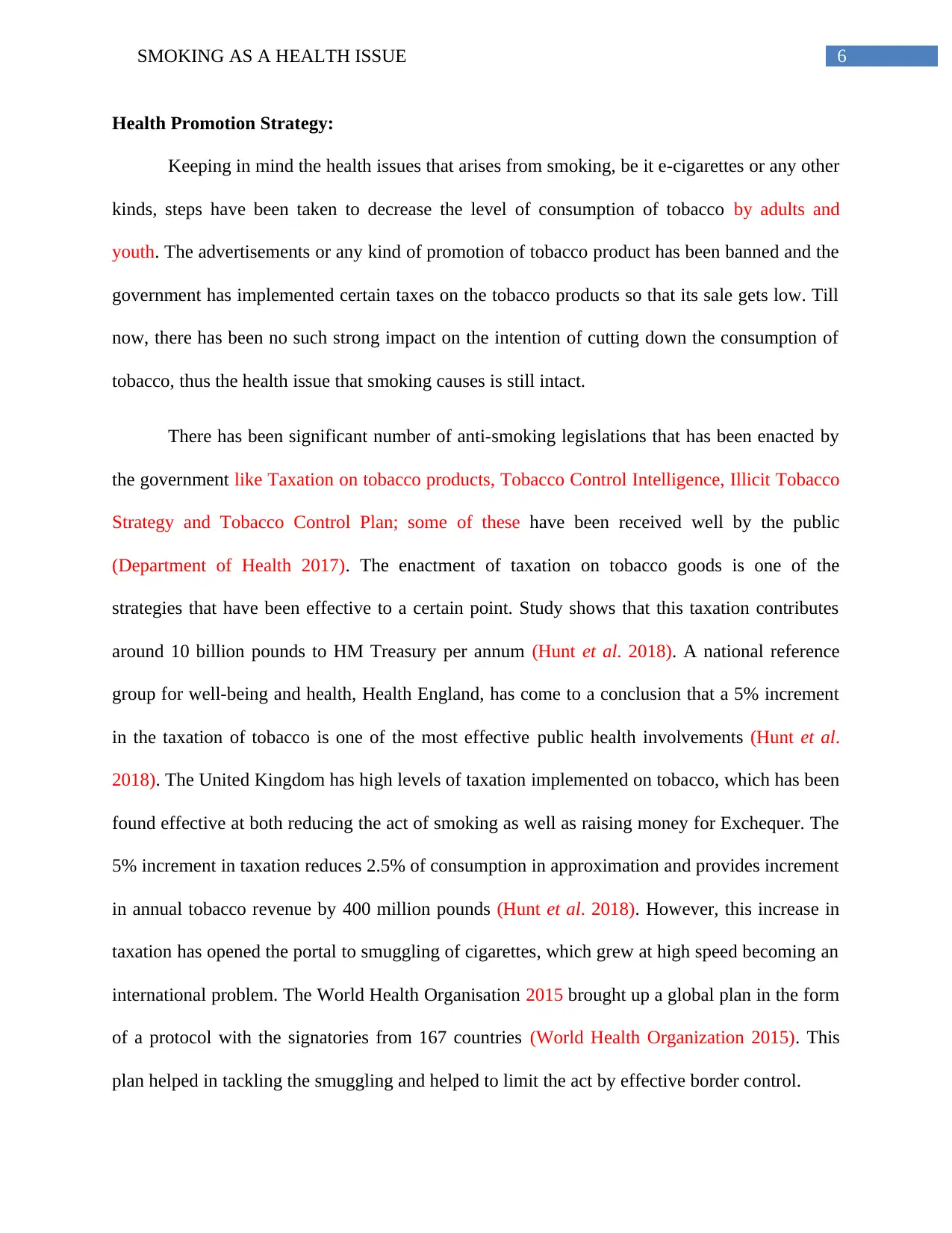
6SMOKING AS A HEALTH ISSUE
Health Promotion Strategy:
Keeping in mind the health issues that arises from smoking, be it e-cigarettes or any other
kinds, steps have been taken to decrease the level of consumption of tobacco by adults and
youth. The advertisements or any kind of promotion of tobacco product has been banned and the
government has implemented certain taxes on the tobacco products so that its sale gets low. Till
now, there has been no such strong impact on the intention of cutting down the consumption of
tobacco, thus the health issue that smoking causes is still intact.
There has been significant number of anti-smoking legislations that has been enacted by
the government like Taxation on tobacco products, Tobacco Control Intelligence, Illicit Tobacco
Strategy and Tobacco Control Plan; some of these have been received well by the public
(Department of Health 2017). The enactment of taxation on tobacco goods is one of the
strategies that have been effective to a certain point. Study shows that this taxation contributes
around 10 billion pounds to HM Treasury per annum (Hunt et al. 2018). A national reference
group for well-being and health, Health England, has come to a conclusion that a 5% increment
in the taxation of tobacco is one of the most effective public health involvements (Hunt et al.
2018). The United Kingdom has high levels of taxation implemented on tobacco, which has been
found effective at both reducing the act of smoking as well as raising money for Exchequer. The
5% increment in taxation reduces 2.5% of consumption in approximation and provides increment
in annual tobacco revenue by 400 million pounds (Hunt et al. 2018). However, this increase in
taxation has opened the portal to smuggling of cigarettes, which grew at high speed becoming an
international problem. The World Health Organisation 2015 brought up a global plan in the form
of a protocol with the signatories from 167 countries (World Health Organization 2015). This
plan helped in tackling the smuggling and helped to limit the act by effective border control.
Health Promotion Strategy:
Keeping in mind the health issues that arises from smoking, be it e-cigarettes or any other
kinds, steps have been taken to decrease the level of consumption of tobacco by adults and
youth. The advertisements or any kind of promotion of tobacco product has been banned and the
government has implemented certain taxes on the tobacco products so that its sale gets low. Till
now, there has been no such strong impact on the intention of cutting down the consumption of
tobacco, thus the health issue that smoking causes is still intact.
There has been significant number of anti-smoking legislations that has been enacted by
the government like Taxation on tobacco products, Tobacco Control Intelligence, Illicit Tobacco
Strategy and Tobacco Control Plan; some of these have been received well by the public
(Department of Health 2017). The enactment of taxation on tobacco goods is one of the
strategies that have been effective to a certain point. Study shows that this taxation contributes
around 10 billion pounds to HM Treasury per annum (Hunt et al. 2018). A national reference
group for well-being and health, Health England, has come to a conclusion that a 5% increment
in the taxation of tobacco is one of the most effective public health involvements (Hunt et al.
2018). The United Kingdom has high levels of taxation implemented on tobacco, which has been
found effective at both reducing the act of smoking as well as raising money for Exchequer. The
5% increment in taxation reduces 2.5% of consumption in approximation and provides increment
in annual tobacco revenue by 400 million pounds (Hunt et al. 2018). However, this increase in
taxation has opened the portal to smuggling of cigarettes, which grew at high speed becoming an
international problem. The World Health Organisation 2015 brought up a global plan in the form
of a protocol with the signatories from 167 countries (World Health Organization 2015). This
plan helped in tackling the smuggling and helped to limit the act by effective border control.
Paraphrase This Document
Need a fresh take? Get an instant paraphrase of this document with our AI Paraphraser
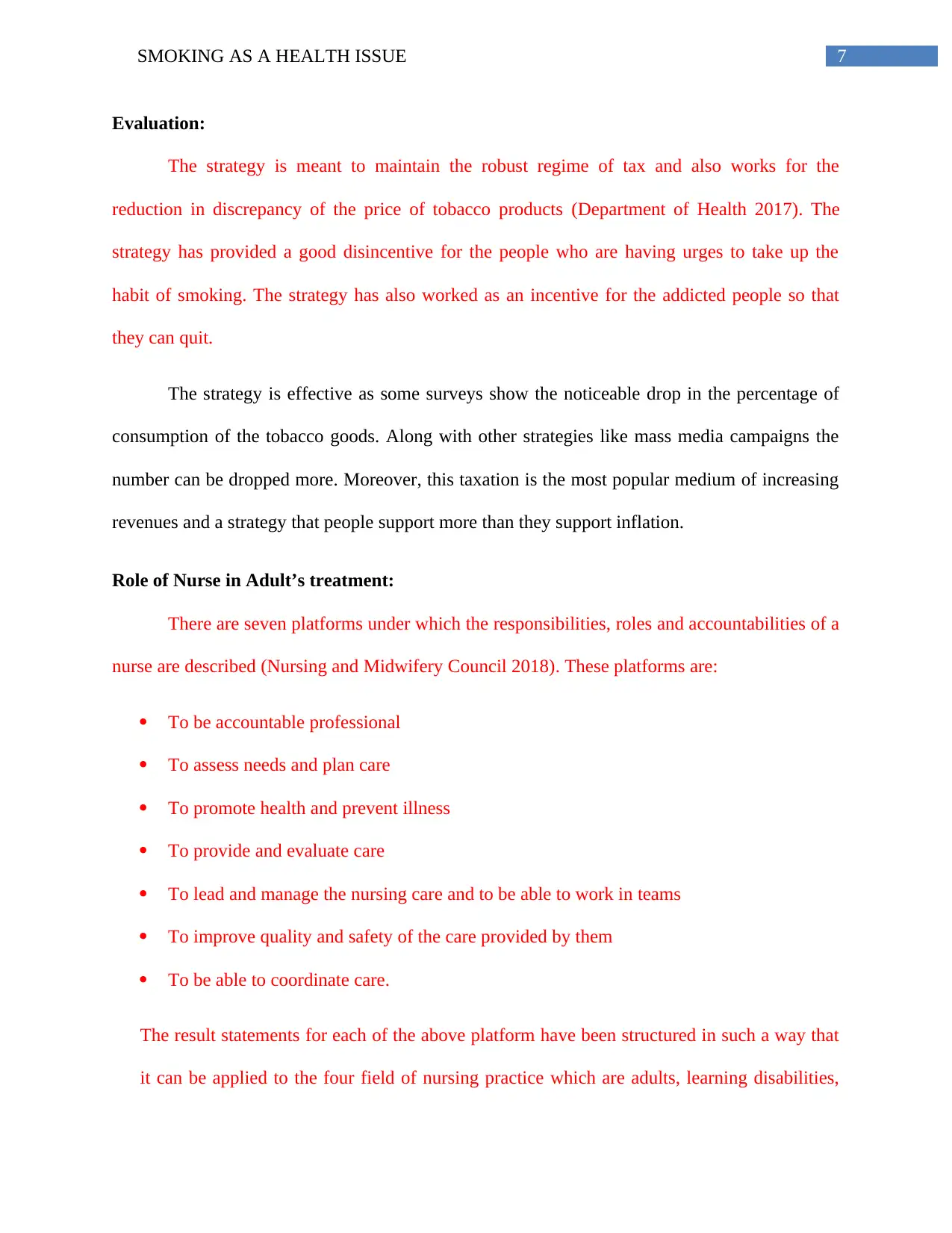
7SMOKING AS A HEALTH ISSUE
Evaluation:
The strategy is meant to maintain the robust regime of tax and also works for the
reduction in discrepancy of the price of tobacco products (Department of Health 2017). The
strategy has provided a good disincentive for the people who are having urges to take up the
habit of smoking. The strategy has also worked as an incentive for the addicted people so that
they can quit.
The strategy is effective as some surveys show the noticeable drop in the percentage of
consumption of the tobacco goods. Along with other strategies like mass media campaigns the
number can be dropped more. Moreover, this taxation is the most popular medium of increasing
revenues and a strategy that people support more than they support inflation.
Role of Nurse in Adult’s treatment:
There are seven platforms under which the responsibilities, roles and accountabilities of a
nurse are described (Nursing and Midwifery Council 2018). These platforms are:
To be accountable professional
To assess needs and plan care
To promote health and prevent illness
To provide and evaluate care
To lead and manage the nursing care and to be able to work in teams
To improve quality and safety of the care provided by them
To be able to coordinate care.
The result statements for each of the above platform have been structured in such a way that
it can be applied to the four field of nursing practice which are adults, learning disabilities,
Evaluation:
The strategy is meant to maintain the robust regime of tax and also works for the
reduction in discrepancy of the price of tobacco products (Department of Health 2017). The
strategy has provided a good disincentive for the people who are having urges to take up the
habit of smoking. The strategy has also worked as an incentive for the addicted people so that
they can quit.
The strategy is effective as some surveys show the noticeable drop in the percentage of
consumption of the tobacco goods. Along with other strategies like mass media campaigns the
number can be dropped more. Moreover, this taxation is the most popular medium of increasing
revenues and a strategy that people support more than they support inflation.
Role of Nurse in Adult’s treatment:
There are seven platforms under which the responsibilities, roles and accountabilities of a
nurse are described (Nursing and Midwifery Council 2018). These platforms are:
To be accountable professional
To assess needs and plan care
To promote health and prevent illness
To provide and evaluate care
To lead and manage the nursing care and to be able to work in teams
To improve quality and safety of the care provided by them
To be able to coordinate care.
The result statements for each of the above platform have been structured in such a way that
it can be applied to the four field of nursing practice which are adults, learning disabilities,
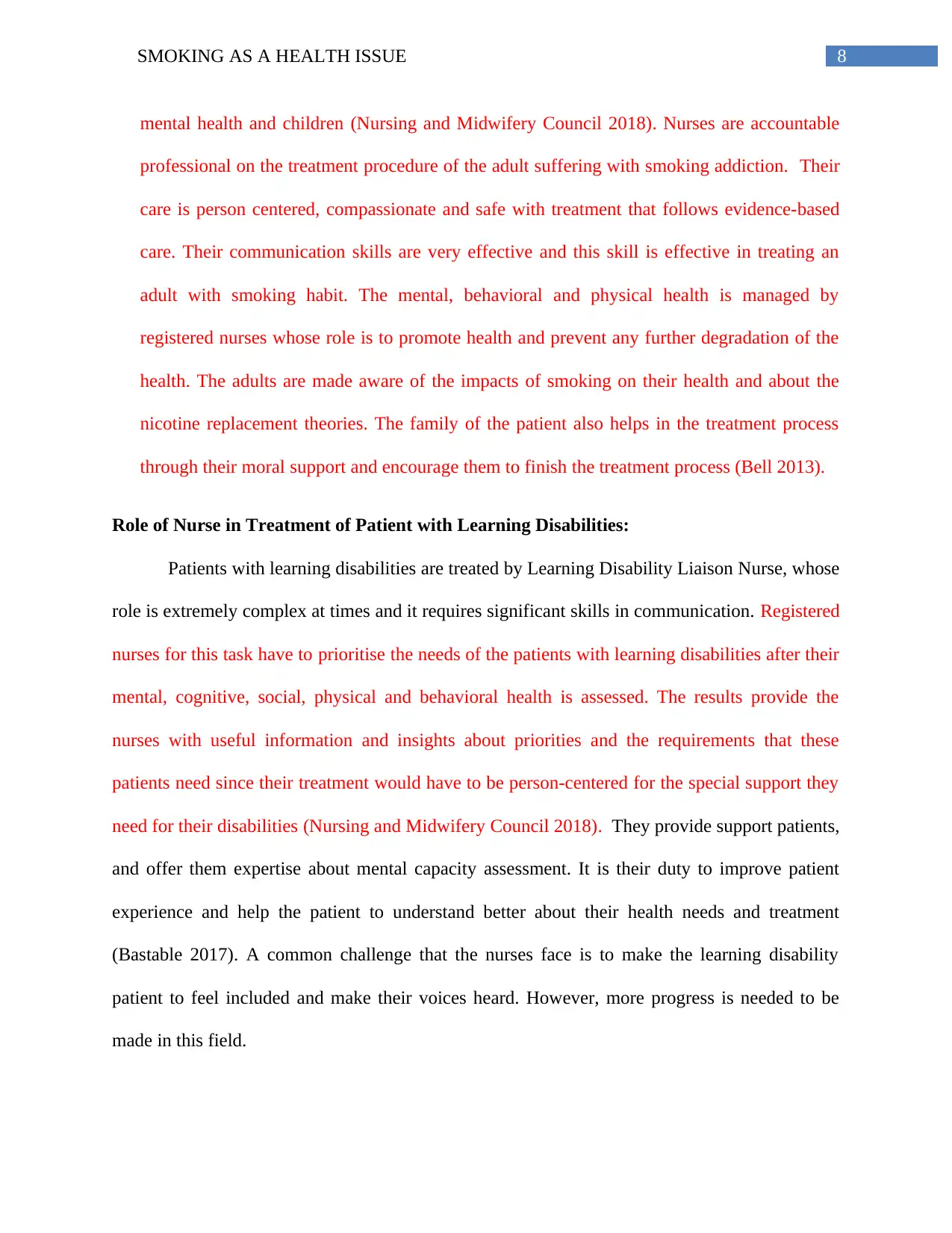
8SMOKING AS A HEALTH ISSUE
mental health and children (Nursing and Midwifery Council 2018). Nurses are accountable
professional on the treatment procedure of the adult suffering with smoking addiction. Their
care is person centered, compassionate and safe with treatment that follows evidence-based
care. Their communication skills are very effective and this skill is effective in treating an
adult with smoking habit. The mental, behavioral and physical health is managed by
registered nurses whose role is to promote health and prevent any further degradation of the
health. The adults are made aware of the impacts of smoking on their health and about the
nicotine replacement theories. The family of the patient also helps in the treatment process
through their moral support and encourage them to finish the treatment process (Bell 2013).
Role of Nurse in Treatment of Patient with Learning Disabilities:
Patients with learning disabilities are treated by Learning Disability Liaison Nurse, whose
role is extremely complex at times and it requires significant skills in communication. Registered
nurses for this task have to prioritise the needs of the patients with learning disabilities after their
mental, cognitive, social, physical and behavioral health is assessed. The results provide the
nurses with useful information and insights about priorities and the requirements that these
patients need since their treatment would have to be person-centered for the special support they
need for their disabilities (Nursing and Midwifery Council 2018). They provide support patients,
and offer them expertise about mental capacity assessment. It is their duty to improve patient
experience and help the patient to understand better about their health needs and treatment
(Bastable 2017). A common challenge that the nurses face is to make the learning disability
patient to feel included and make their voices heard. However, more progress is needed to be
made in this field.
mental health and children (Nursing and Midwifery Council 2018). Nurses are accountable
professional on the treatment procedure of the adult suffering with smoking addiction. Their
care is person centered, compassionate and safe with treatment that follows evidence-based
care. Their communication skills are very effective and this skill is effective in treating an
adult with smoking habit. The mental, behavioral and physical health is managed by
registered nurses whose role is to promote health and prevent any further degradation of the
health. The adults are made aware of the impacts of smoking on their health and about the
nicotine replacement theories. The family of the patient also helps in the treatment process
through their moral support and encourage them to finish the treatment process (Bell 2013).
Role of Nurse in Treatment of Patient with Learning Disabilities:
Patients with learning disabilities are treated by Learning Disability Liaison Nurse, whose
role is extremely complex at times and it requires significant skills in communication. Registered
nurses for this task have to prioritise the needs of the patients with learning disabilities after their
mental, cognitive, social, physical and behavioral health is assessed. The results provide the
nurses with useful information and insights about priorities and the requirements that these
patients need since their treatment would have to be person-centered for the special support they
need for their disabilities (Nursing and Midwifery Council 2018). They provide support patients,
and offer them expertise about mental capacity assessment. It is their duty to improve patient
experience and help the patient to understand better about their health needs and treatment
(Bastable 2017). A common challenge that the nurses face is to make the learning disability
patient to feel included and make their voices heard. However, more progress is needed to be
made in this field.
⊘ This is a preview!⊘
Do you want full access?
Subscribe today to unlock all pages.

Trusted by 1+ million students worldwide
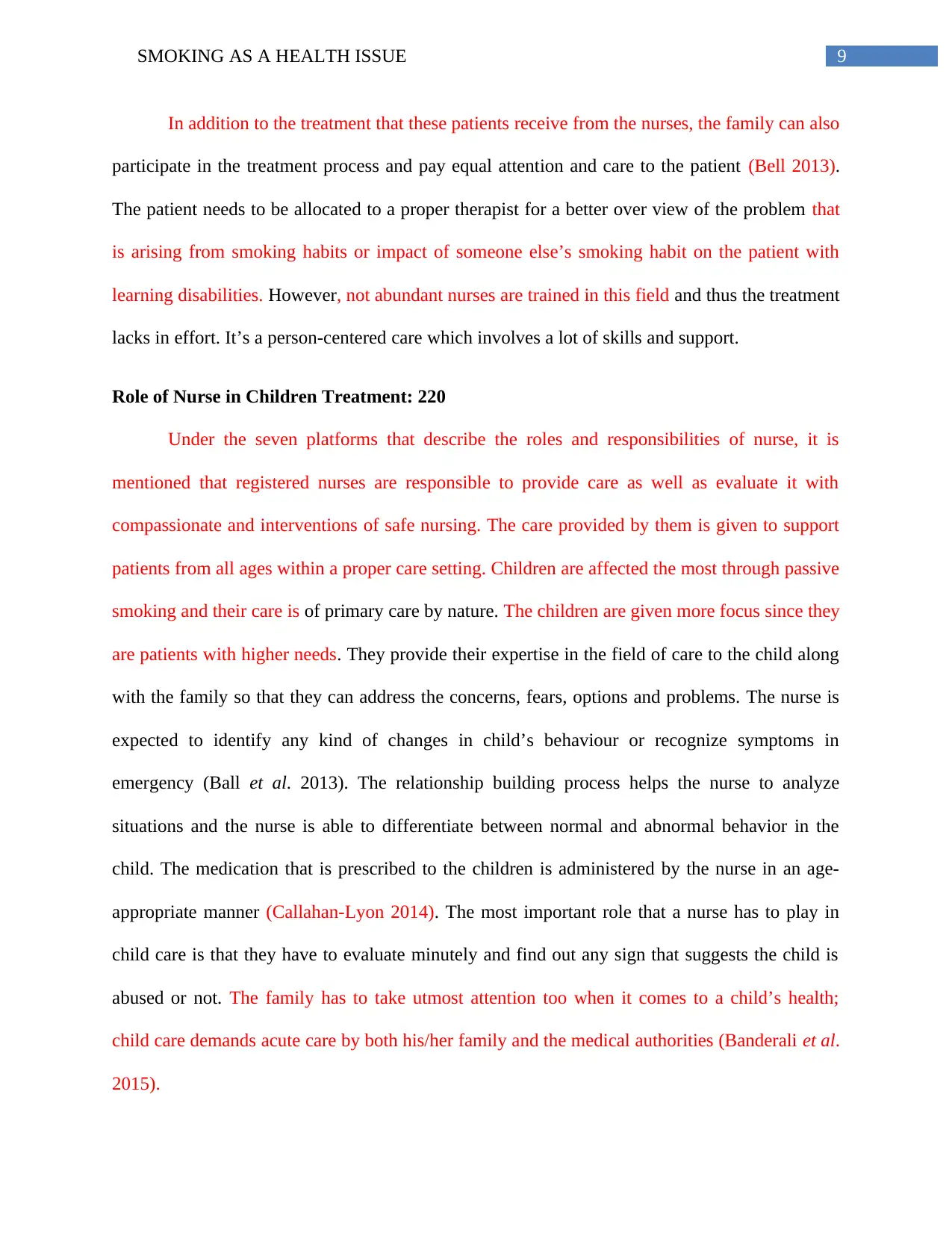
9SMOKING AS A HEALTH ISSUE
In addition to the treatment that these patients receive from the nurses, the family can also
participate in the treatment process and pay equal attention and care to the patient (Bell 2013).
The patient needs to be allocated to a proper therapist for a better over view of the problem that
is arising from smoking habits or impact of someone else’s smoking habit on the patient with
learning disabilities. However, not abundant nurses are trained in this field and thus the treatment
lacks in effort. It’s a person-centered care which involves a lot of skills and support.
Role of Nurse in Children Treatment: 220
Under the seven platforms that describe the roles and responsibilities of nurse, it is
mentioned that registered nurses are responsible to provide care as well as evaluate it with
compassionate and interventions of safe nursing. The care provided by them is given to support
patients from all ages within a proper care setting. Children are affected the most through passive
smoking and their care is of primary care by nature. The children are given more focus since they
are patients with higher needs. They provide their expertise in the field of care to the child along
with the family so that they can address the concerns, fears, options and problems. The nurse is
expected to identify any kind of changes in child’s behaviour or recognize symptoms in
emergency (Ball et al. 2013). The relationship building process helps the nurse to analyze
situations and the nurse is able to differentiate between normal and abnormal behavior in the
child. The medication that is prescribed to the children is administered by the nurse in an age-
appropriate manner (Callahan-Lyon 2014). The most important role that a nurse has to play in
child care is that they have to evaluate minutely and find out any sign that suggests the child is
abused or not. The family has to take utmost attention too when it comes to a child’s health;
child care demands acute care by both his/her family and the medical authorities (Banderali et al.
2015).
In addition to the treatment that these patients receive from the nurses, the family can also
participate in the treatment process and pay equal attention and care to the patient (Bell 2013).
The patient needs to be allocated to a proper therapist for a better over view of the problem that
is arising from smoking habits or impact of someone else’s smoking habit on the patient with
learning disabilities. However, not abundant nurses are trained in this field and thus the treatment
lacks in effort. It’s a person-centered care which involves a lot of skills and support.
Role of Nurse in Children Treatment: 220
Under the seven platforms that describe the roles and responsibilities of nurse, it is
mentioned that registered nurses are responsible to provide care as well as evaluate it with
compassionate and interventions of safe nursing. The care provided by them is given to support
patients from all ages within a proper care setting. Children are affected the most through passive
smoking and their care is of primary care by nature. The children are given more focus since they
are patients with higher needs. They provide their expertise in the field of care to the child along
with the family so that they can address the concerns, fears, options and problems. The nurse is
expected to identify any kind of changes in child’s behaviour or recognize symptoms in
emergency (Ball et al. 2013). The relationship building process helps the nurse to analyze
situations and the nurse is able to differentiate between normal and abnormal behavior in the
child. The medication that is prescribed to the children is administered by the nurse in an age-
appropriate manner (Callahan-Lyon 2014). The most important role that a nurse has to play in
child care is that they have to evaluate minutely and find out any sign that suggests the child is
abused or not. The family has to take utmost attention too when it comes to a child’s health;
child care demands acute care by both his/her family and the medical authorities (Banderali et al.
2015).
Paraphrase This Document
Need a fresh take? Get an instant paraphrase of this document with our AI Paraphraser
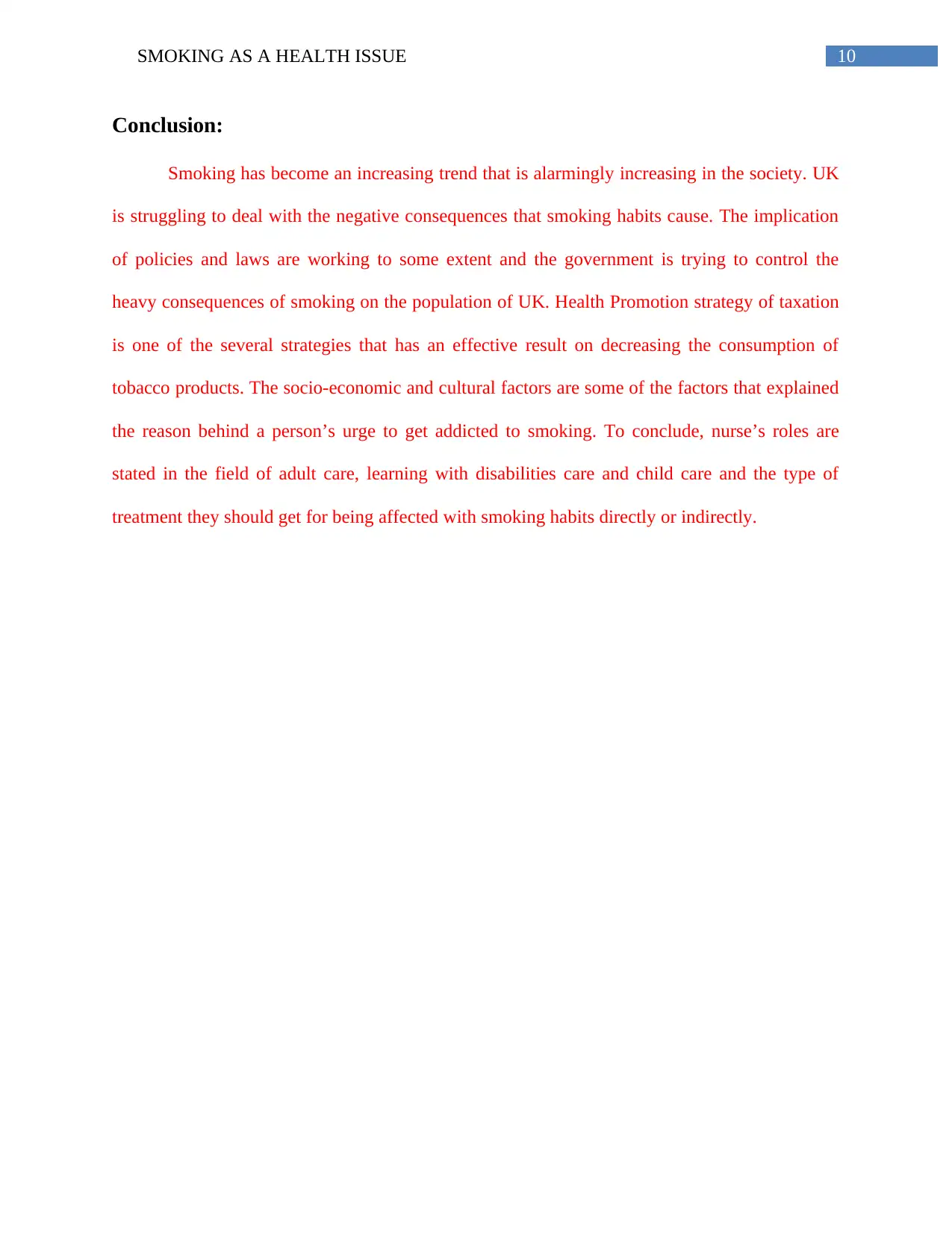
10SMOKING AS A HEALTH ISSUE
Conclusion:
Smoking has become an increasing trend that is alarmingly increasing in the society. UK
is struggling to deal with the negative consequences that smoking habits cause. The implication
of policies and laws are working to some extent and the government is trying to control the
heavy consequences of smoking on the population of UK. Health Promotion strategy of taxation
is one of the several strategies that has an effective result on decreasing the consumption of
tobacco products. The socio-economic and cultural factors are some of the factors that explained
the reason behind a person’s urge to get addicted to smoking. To conclude, nurse’s roles are
stated in the field of adult care, learning with disabilities care and child care and the type of
treatment they should get for being affected with smoking habits directly or indirectly.
Conclusion:
Smoking has become an increasing trend that is alarmingly increasing in the society. UK
is struggling to deal with the negative consequences that smoking habits cause. The implication
of policies and laws are working to some extent and the government is trying to control the
heavy consequences of smoking on the population of UK. Health Promotion strategy of taxation
is one of the several strategies that has an effective result on decreasing the consumption of
tobacco products. The socio-economic and cultural factors are some of the factors that explained
the reason behind a person’s urge to get addicted to smoking. To conclude, nurse’s roles are
stated in the field of adult care, learning with disabilities care and child care and the type of
treatment they should get for being affected with smoking habits directly or indirectly.
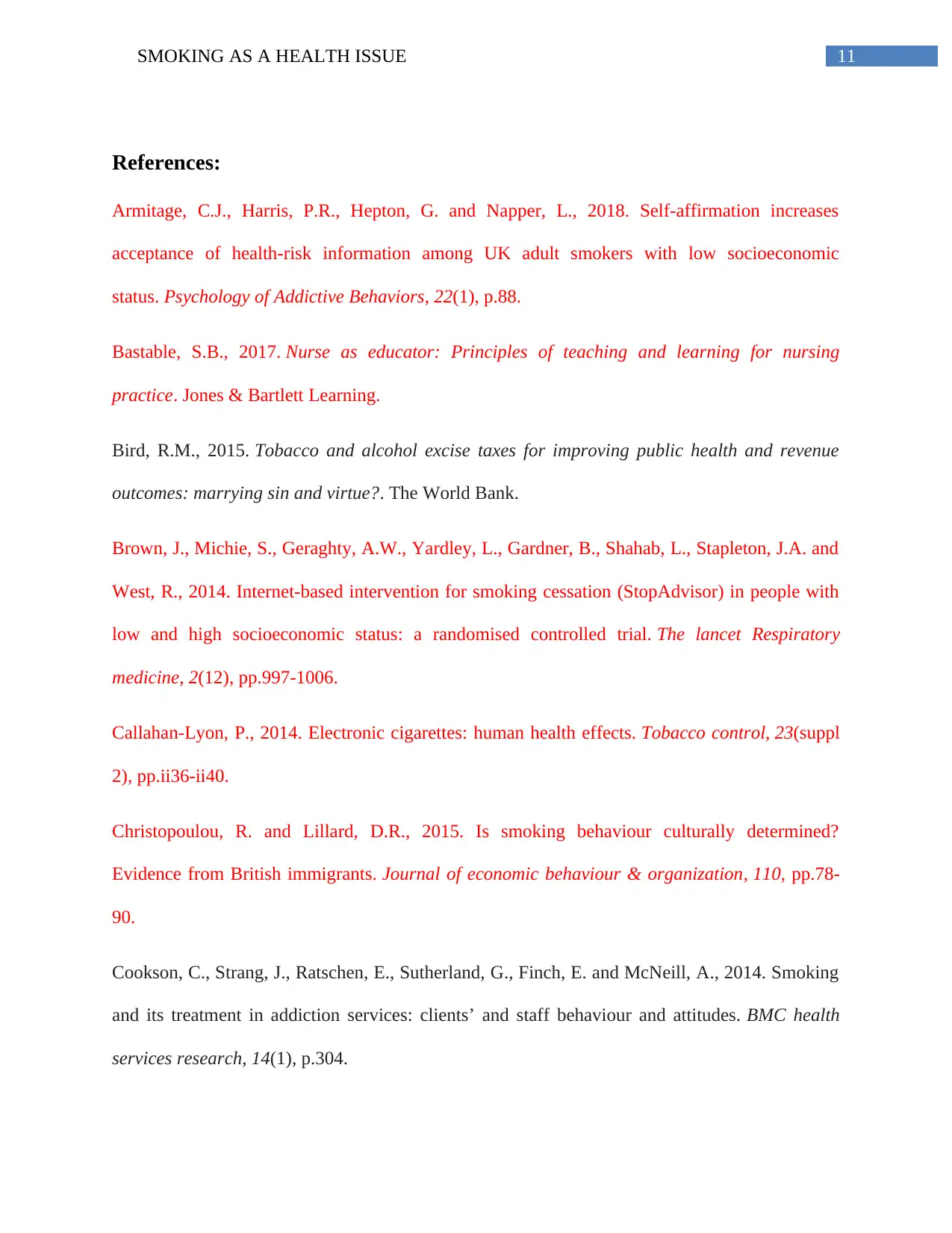
11SMOKING AS A HEALTH ISSUE
References:
Armitage, C.J., Harris, P.R., Hepton, G. and Napper, L., 2018. Self-affirmation increases
acceptance of health-risk information among UK adult smokers with low socioeconomic
status. Psychology of Addictive Behaviors, 22(1), p.88.
Bastable, S.B., 2017. Nurse as educator: Principles of teaching and learning for nursing
practice. Jones & Bartlett Learning.
Bird, R.M., 2015. Tobacco and alcohol excise taxes for improving public health and revenue
outcomes: marrying sin and virtue?. The World Bank.
Brown, J., Michie, S., Geraghty, A.W., Yardley, L., Gardner, B., Shahab, L., Stapleton, J.A. and
West, R., 2014. Internet-based intervention for smoking cessation (StopAdvisor) in people with
low and high socioeconomic status: a randomised controlled trial. The lancet Respiratory
medicine, 2(12), pp.997-1006.
Callahan-Lyon, P., 2014. Electronic cigarettes: human health effects. Tobacco control, 23(suppl
2), pp.ii36-ii40.
Christopoulou, R. and Lillard, D.R., 2015. Is smoking behaviour culturally determined?
Evidence from British immigrants. Journal of economic behaviour & organization, 110, pp.78-
90.
Cookson, C., Strang, J., Ratschen, E., Sutherland, G., Finch, E. and McNeill, A., 2014. Smoking
and its treatment in addiction services: clients’ and staff behaviour and attitudes. BMC health
services research, 14(1), p.304.
References:
Armitage, C.J., Harris, P.R., Hepton, G. and Napper, L., 2018. Self-affirmation increases
acceptance of health-risk information among UK adult smokers with low socioeconomic
status. Psychology of Addictive Behaviors, 22(1), p.88.
Bastable, S.B., 2017. Nurse as educator: Principles of teaching and learning for nursing
practice. Jones & Bartlett Learning.
Bird, R.M., 2015. Tobacco and alcohol excise taxes for improving public health and revenue
outcomes: marrying sin and virtue?. The World Bank.
Brown, J., Michie, S., Geraghty, A.W., Yardley, L., Gardner, B., Shahab, L., Stapleton, J.A. and
West, R., 2014. Internet-based intervention for smoking cessation (StopAdvisor) in people with
low and high socioeconomic status: a randomised controlled trial. The lancet Respiratory
medicine, 2(12), pp.997-1006.
Callahan-Lyon, P., 2014. Electronic cigarettes: human health effects. Tobacco control, 23(suppl
2), pp.ii36-ii40.
Christopoulou, R. and Lillard, D.R., 2015. Is smoking behaviour culturally determined?
Evidence from British immigrants. Journal of economic behaviour & organization, 110, pp.78-
90.
Cookson, C., Strang, J., Ratschen, E., Sutherland, G., Finch, E. and McNeill, A., 2014. Smoking
and its treatment in addiction services: clients’ and staff behaviour and attitudes. BMC health
services research, 14(1), p.304.
⊘ This is a preview!⊘
Do you want full access?
Subscribe today to unlock all pages.

Trusted by 1+ million students worldwide
1 out of 14
Related Documents
Your All-in-One AI-Powered Toolkit for Academic Success.
+13062052269
info@desklib.com
Available 24*7 on WhatsApp / Email
![[object Object]](/_next/static/media/star-bottom.7253800d.svg)
Unlock your academic potential
Copyright © 2020–2025 A2Z Services. All Rights Reserved. Developed and managed by ZUCOL.





